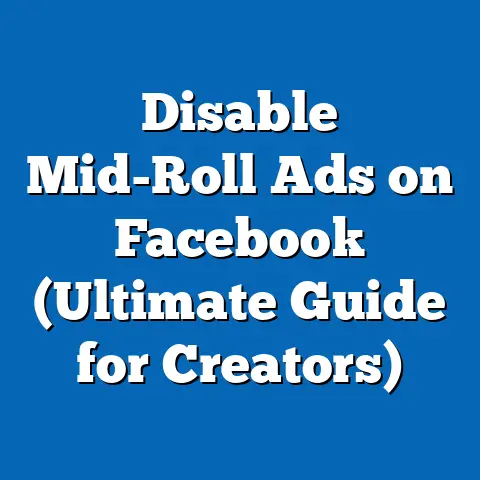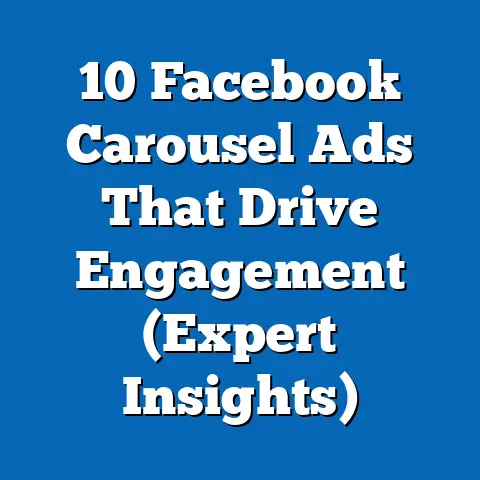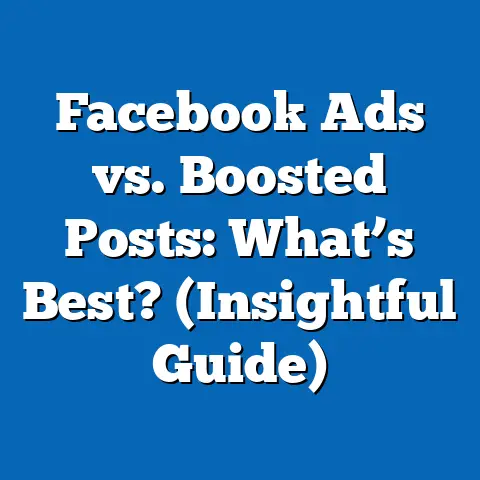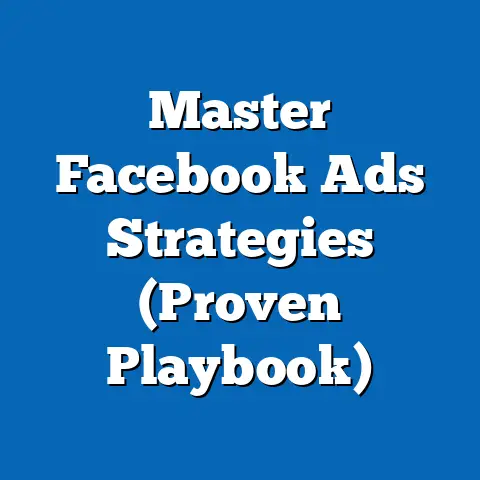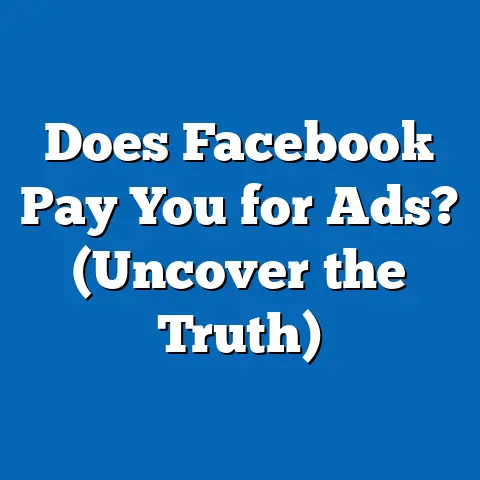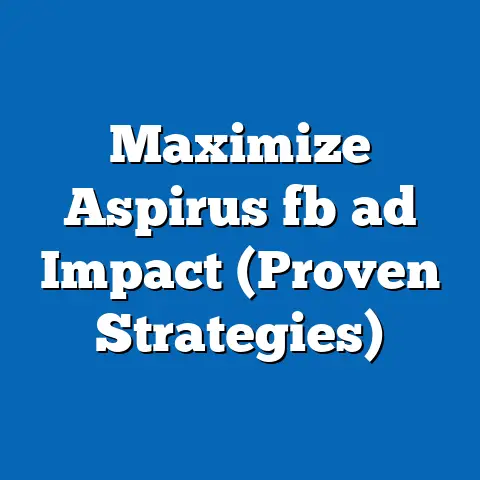Revolutionize Facebook Ads with 360 Images (Creative Strategy)
In today’s hyper-competitive digital landscape, simply showing up on Facebook isn’t enough. We’re bombarded with ads daily, and the average user is becoming increasingly adept at tuning them out. That’s why innovation is no longer a luxury in digital marketing; it’s a necessity. If you want to cut through the noise and capture the attention of your target audience, you need to think outside the box and embrace creative strategies that offer something truly unique.
Enter 360 images. These aren’t your grandma’s static photos. They’re immersive experiences that allow users to explore a scene, a product, or even an entire world from the comfort of their own device. By offering a dynamic and engaging alternative to traditional advertising formats, 360 images can transform your Facebook ads from mere interruptions into captivating experiences. I remember the first time I saw a 360 ad for a travel agency – it literally felt like I was standing on a beach in the Bahamas! That’s the power of this technology.
The trend towards interactive content in social media marketing is undeniable. Consumers crave engagement, and they want to feel like they’re part of the story. 360 images deliver on this desire by placing the user in the driver’s seat, allowing them to explore and interact with your brand in a way that’s both memorable and meaningful. In this article, I’ll dive deep into the world of 360 images and show you how to harness their potential to revolutionize your Facebook ad campaigns.
Understanding 360 Images
So, what exactly are 360 images? Simply put, they’re panoramic photos that allow viewers to explore a scene in a full 360-degree view. Unlike traditional images, which offer a limited perspective, 360 images provide an immersive experience that feels almost like being there in person. Think of it as a virtual window into another world. You can pan left, right, up, and down, exploring every nook and cranny of the scene.
The technology behind 360 photography has come a long way in recent years. Originally, creating these images required specialized equipment and technical expertise. However, thanks to advancements in camera technology, capturing 360 images is now more accessible than ever. You can use dedicated 360 cameras like the Ricoh Theta or the Insta360 series, or even some smartphones that have built-in 360 capabilities. The process typically involves capturing multiple images from different angles and then stitching them together using specialized software to create a seamless panoramic view.
Several industries and brands have already recognized the potential of 360 images and are using them to create engaging marketing campaigns. The travel industry, as I mentioned earlier, is a natural fit. Imagine showcasing breathtaking views of a hotel resort or a stunning landscape through a 360 image. Real estate companies are also leveraging this technology to offer virtual tours of properties, allowing potential buyers to explore a home without ever stepping foot inside. Even retail brands are getting in on the action, using 360 images to showcase products in a dynamic and interactive way.
For example, a furniture company might use a 360 image to allow customers to explore a living room set, zooming in on details and getting a feel for the overall design. Or an automotive brand could use a 360 image to let potential buyers explore the interior of a new car model, highlighting its features and design elements. The possibilities are truly endless. The visual and engagement benefits are clear: 360 images capture attention, encourage interaction, and create a memorable experience that sets your brand apart from the competition.
The Psychological Impact of 360 Images
Beyond the technical aspects, it’s important to understand the psychological impact of 360 images on viewers. Why are they so effective at capturing attention and driving engagement? The answer lies in the immersive nature of the experience. When someone interacts with a 360 image, they’re not just passively viewing content; they’re actively exploring and participating in the scene. This active involvement triggers a different set of psychological responses compared to traditional advertising formats.
One of the key benefits of 360 images is their ability to capture attention. In a world where attention spans are shrinking, anything that can grab and hold someone’s focus is incredibly valuable. The novelty and immersive nature of 360 images make them naturally attention-grabbing. It’s hard to scroll past a 360 image without at least pausing to take a look.
But it’s not just about capturing attention; it’s also about increasing retention rates. Studies have shown that people are more likely to remember information when it’s presented in an engaging and interactive way. 360 images excel at this, allowing users to explore a scene and discover information at their own pace. This self-directed exploration leads to deeper engagement and better retention of the message.
For instance, I remember seeing a study where participants who viewed a product demonstration through a 360 video were significantly more likely to recall the product’s features compared to those who watched a traditional video. The difference was attributed to the immersive nature of the 360 experience, which allowed participants to feel more connected to the product.
Furthermore, 360 images can foster a stronger emotional connection with your brand. By creating immersive experiences, you’re allowing users to step into your world and see things from your perspective. This creates a sense of intimacy and connection that’s difficult to achieve with traditional advertising formats. When people feel emotionally connected to your brand, they’re more likely to become loyal customers.
The key takeaway here is that 360 images are more than just a visual gimmick. They tap into fundamental psychological principles that drive engagement, increase retention, and foster emotional connections. By understanding these principles, you can create 360 ad campaigns that are not only visually stunning but also psychologically effective.
Crafting a Facebook Ad Strategy with 360 Images
Now that you understand the power of 360 images, let’s dive into the practical aspects of crafting a Facebook ad strategy around them. Here’s a step-by-step approach to integrating 360 images into your campaigns:
Step 1: Identifying the Target Audience and Understanding Their Preferences.
This is the foundation of any successful advertising campaign, regardless of the format. Before you even think about creating your 360 image, you need to have a clear understanding of who you’re trying to reach. What are their demographics? What are their interests? What are their pain points? The more you know about your target audience, the better you’ll be able to create 360 content that resonates with them.
For example, if you’re targeting millennials interested in sustainable travel, you might create a 360 image showcasing an eco-friendly resort in Costa Rica. Or if you’re targeting young professionals looking for new furniture, you might create a 360 image showcasing a modern apartment design.
Step 2: Selecting Appropriate 360 Content That Aligns with the Brand and Resonates with the Target Audience.
Once you know who you’re targeting, it’s time to choose the right 360 content. This means selecting images that are not only visually stunning but also relevant to your brand and appealing to your target audience. Think about what kind of experiences they’re looking for and how you can deliver that through your 360 images.
For instance, a luxury brand might use 360 images to showcase exclusive events or behind-the-scenes glimpses of their design process. Or a tech company might use 360 images to offer virtual tours of their office spaces or product demos.
Step 3: Creating Engaging Captions and Calls-to-Action That Complement the 360 Images.
Your 360 image is only part of the equation. You also need to create compelling captions and calls-to-action that encourage interaction. Your caption should provide context for the image and highlight its key features. Your call-to-action should tell users what you want them to do next, whether it’s visiting your website, signing up for a newsletter, or making a purchase.
For example, if you’re showcasing a new product in a 360 image, your caption might highlight its unique features and benefits. Your call-to-action might encourage users to “Shop Now” or “Learn More.”
Step 4: Utilizing Facebook’s Ad Tools to Optimize the Reach and Performance of 360 Image Ads.
Facebook offers a range of ad tools that can help you optimize the reach and performance of your 360 image ads. You can use targeting options to reach specific demographics and interests. You can use A/B testing to experiment with different captions and calls-to-action. And you can use analytics to track the performance of your ads and make adjustments as needed.
For example, you might use Facebook’s Lookalike Audiences feature to reach people who are similar to your existing customers. Or you might use Facebook Pixel to track conversions on your website and measure the ROI of your ad campaigns.
Beyond these steps, here are some best practices for creating high-quality 360 images that capture attention and encourage interaction:
- Invest in high-quality equipment: The quality of your 360 image will directly impact its effectiveness. Use a good quality 360 camera and ensure proper lighting.
- Focus on composition: Just like with traditional photography, composition is key. Think about how you want to frame the scene and guide the viewer’s eye.
- Edit your images carefully: Use editing software to enhance the colors, sharpness, and overall quality of your 360 images.
- Optimize for mobile: Most people will be viewing your 360 images on their smartphones, so make sure they’re optimized for mobile viewing.
- Experiment with different angles and perspectives: Don’t be afraid to get creative with your 360 images. Try shooting from different angles and perspectives to create a unique and engaging experience.
Case Studies of Successful Campaigns
To further illustrate the potential of 360 images in Facebook advertising, let’s take a look at some real-world examples of successful campaigns:
Case Study 1: Marriott Hotels
Marriott Hotels used 360 videos to give potential guests virtual tours of their hotel rooms and amenities. The objective was to increase bookings and drive revenue. They created immersive experiences that allowed users to explore the hotel rooms, restaurants, and pools from the comfort of their own homes.
The strategy employed was to target travelers who were researching destinations and hotels on Facebook. They used Facebook’s targeting options to reach people who were interested in travel, luxury hotels, and specific destinations.
The measurable outcomes were impressive. Marriott saw a significant increase in bookings from users who interacted with their 360 videos. They also saw a boost in brand awareness and positive sentiment.
Case Study 2: Topshop
Topshop, a popular fashion retailer, used 360 videos to showcase their latest collections in a dynamic and engaging way. The objective was to drive sales and increase brand engagement. They created virtual fashion shows that allowed users to explore the latest trends and styles.
The strategy employed was to target fashion-conscious consumers on Facebook. They used Facebook’s targeting options to reach people who were interested in fashion, style, and specific clothing brands.
The measurable outcomes were equally impressive. Topshop saw a significant increase in sales from users who interacted with their 360 videos. They also saw a boost in brand engagement and social media shares.
Case Study 3: The North Face
The North Face used a 360° video to showcase the experience of climbing El Capitan. This allowed viewers to feel like they were part of the adventure, creating an emotional connection with the brand. The campaign aimed to highlight the resilience and capabilities of their equipment.
Their strategy focused on targeting outdoor enthusiasts and adventure seekers on Facebook. They emphasized the authenticity of the experience, using real climbers and breathtaking scenery.
The results included increased brand awareness and positive sentiment among their target audience. The immersive experience resonated deeply with viewers, translating into higher engagement rates and a stronger association between The North Face and extreme adventure.
These case studies demonstrate the power of 360 images to drive results across a range of industries. By creating immersive experiences, you can capture attention, increase engagement, and drive conversions.
Conclusion
In conclusion, 360 images offer a transformative opportunity for Facebook advertisers. By moving beyond traditional static images and embracing immersive experiences, you can capture attention, increase engagement, and drive results. From travel and real estate to retail and automotive, the possibilities are endless.
I encourage you to embrace this innovative strategy and consider how it can enhance your own advertising efforts. Experiment with different types of 360 content, test different captions and calls-to-action, and track your results carefully.
As Facebook advertising continues to evolve, emerging technologies like 360 images will play an increasingly important role in shaping the digital marketing landscape. By staying ahead of the curve and embracing these innovations, you can position your brand for success in the years to come. The future of Facebook advertising is interactive, immersive, and engaging. Are you ready to be a part of it?

